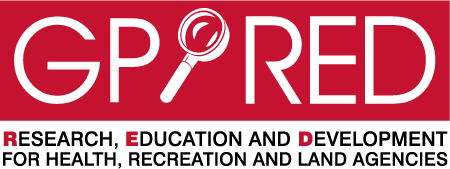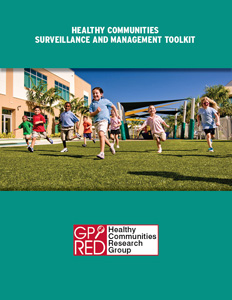
Healthy Communities Research Group
The GP RED Healthy Communities Research Group (HCRG) helps parks, recreation, public health, and related departments and organizations use a Systems Thinking Approach to assess, analyze, document, and evaluate five key elements related to the repositioning of parks and recreation agencies as a primary provider of activities that impact public health in communities using systems and tools for:
- Convening Community Stakeholders and Champions – Residents? Partners? Providers?
- Creating a Warrant for Agency Action – Why? Who? What is the Impact?
- Policies, Laws, and Procedures – What is influencing active living? Transportation? Safety?
- Inventory of Assets and Affordances – Programs? Parks? Trails? Facilities? Food? Gaps?
- Fiscal Resources and Distribution – What funds? How should they be allocated?
HCRG’S SURVEILLANCE AND MANAGEMENT TOOLKIT (SMT)
 Since 2009, the Healthy Communities Research Group (HCRG) has been working with Alpha and Beta test agencies around the country to develop the Healthy Communities Surveillance and Management Toolkit™. GP RED has created and updated the SMT through national research (Penbrooke, 2017), and invites agencies to use the proven process, methods, and strategies to address preventive health in your communities.
Since 2009, the Healthy Communities Research Group (HCRG) has been working with Alpha and Beta test agencies around the country to develop the Healthy Communities Surveillance and Management Toolkit™. GP RED has created and updated the SMT through national research (Penbrooke, 2017), and invites agencies to use the proven process, methods, and strategies to address preventive health in your communities.
The toolkit is designed to be a community and agency resource for a catalytic approach to increasing active living and reducing obesity, and includes data collection templates and step-by-step instructions for implementing the five key elements necessary to reposition parks and recreation agencies as primary community public health providers.
Become a Healthy Community Site
Is your community interested in becoming a GP RED Healthy Community Site using the SMT?HEALTHY COMMUNITIES RESEARCH GROUP PROJECT DOCUMENTS:
![]()
- Beta Sites Overview – HCRG 2017
- Application for Beta Sites
- Arlington Heights YANS Report 11-15
- Arlington Heights Year One Report
- Arlington Heights Year Two Report
- South Bend, Indiana Year One Report
- South Bend HCRG Year Two Report
- South Bend HCRG Year Three Report
- SB HCRG Findings Report 2-17-12
- Liberty HCRG Findings Report FINAL
- Liberty Year One Report and Action Plan
- Liberty Year Two Report
- Liberty Year Three Report
- Halifax, North Carolina YANS Report, Dec. 2015
- Halifax, North Carolina YANS Report Presentation
An analysis of these elements through the SMT process involves key local stakeholders (public health, transportation, schools, for profit/non-profit partners, youth, parents, and other stakeholders) to create a systems portfolio, strategic concepts for improvement, and future modeling for the purposes of articulation, prioritization, management, and surveillance of outcomes over time.

